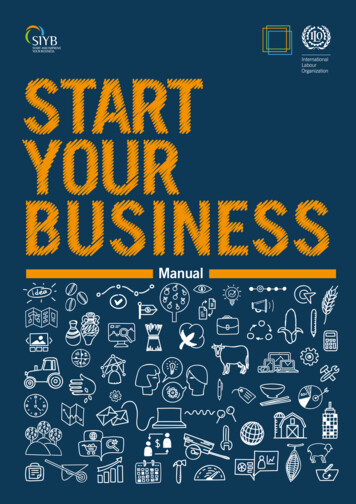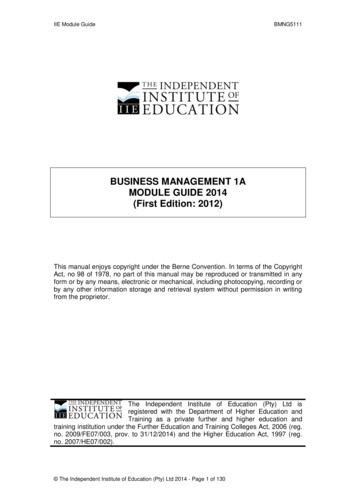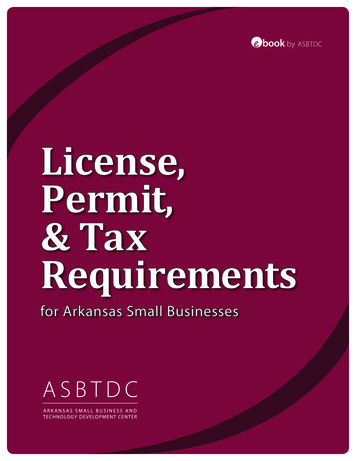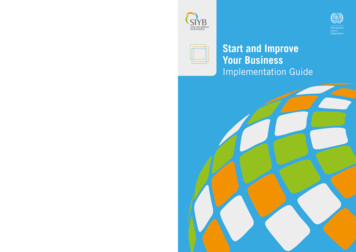
Transcription
BUSINESSSTART-UP GUIDE
INTRODUCTIONIf you dream of owning your own business, it’s important tomake sure you cover all the business planning componentsto be able to start, grow and manage your businesssuccessfully.Whether you want financial success or to turn your passioninto a livelihood, transforming the idea of being your ownboss into reality doesn’t have to be daunting.CONTENTS1.Why you are going into business2.Establish whether there’s a marketWe know that owner-operated businesses are the lifeblood of the Hawaii economy, and every day, people likeyou talk to our Business Relationship Managers aboutgetting into business for themselves.3.Analyze your competitors4.Determine financial feasibility5.Raising capitalThis Business Start-Up Guide is designed to help you turnthat desire to start your own business into a reality. Wehave selected some important topics that you shouldreview before you open your doors.6.Things you need to do7.Building awareness8.Employing staffFurther small business information, resources andbusiness templates are available inside the small businessresource section of our website.9.Lower your risk10. On-going help
STEP ONEWhy you are going into businessAs well as having the required level of skill, ability,knowledge, and experience to run your business, you mustbe prepared to work hard and be clear about why you’regoing into business.Many people find the thought of working for themselvesquite appealing. Being your own boss offers the freedomto: Work your own hours. Make your own decisions. Create your own lifestyle.However, establishing a successful business requires morethan a great idea and a willingness to give it a go.Are you clear about why you are going into business?For example, you might be aiming to: Make more money than you could as an employee. Be independent. Represent a product or service you feel passionateabout. Create a business you can leave for family. Build a business that you intend to sell. Have a better work/life balance.Once you’re clear about why you’d like to be yourown boss, it’s time to take a close look at yourself anddetermine if you have what it takes to run your ownbusiness.CONFIRM YOU HAVE THE NECESSARY SKILLS AND ATTRIBUTESThis self-assessment guide will help you get a feel of whether you’re ready to be self-employed. The more of thesecharacteristics you have, the more comfortable you’re likely to feel about starting and running your own business. You have years of experience in the industry you planto enter You enjoy making and being responsible for yourown decisions You’re prepared to undergo training to develop theskills you need or to get input from specialist advisors You’re prepared to accept a lower income until yourbusiness starts to make a profit You’re prepared to work long hours without thesecurity of a steady income You naturally look to streamline processes andmethods when approaching a task You have sufficient savings or an alternative incometo live off during the start-up period You’re prepared to take the risk of losing the moneyyou invest in your new business Your family understands the impact starting a newbusiness could have on them and support you inachieving your goals You’re prepared to hire staff and delegateresponsibilities to them or use the services of aprofessional if needed You thrive on challengesIf you believe you have what it takes, you’ll now need to decide if your idea does too.TIPKNOW SOMEONE IN BUSINESS?Talk to someone who’s started their own business to gain an understanding of their challenges andsee if it’s right for you.STEP ONE Why you are going into business1
STEP TWOEstablish whether there’s a marketYou’ll need a sustainable market for your goods or services (where your business generates on-going sales), so it’simportant to investigate that market potential by observing what prospective customers really think.Profile your ideal customers to gain an accurate analysis ofmarket potential. To focus your marketing more effectivelyyou’ll want to identify: If there’s a need for your product or service.Consider utilizing surveys, one-on-one interviews or focusgroups to collect data on your target customers. If yourresearch generates some positive feedback, consider testmarketing your product or service (before you give up yourday job). The characteristics of your “ideal” customer. Ways to research the potential size of your market. Trends that could affect your venture.Consider how you will sell to the market. Look at industryand market trends, and global and local influencers, so youcan identify any threats or opportunities ahead.Investigate market potentialThe only guaranteed way to find out exactly how themarket will respond to your business is to start operatingand see what happens. Before you start, collect solidevidence that a market for your product or service actuallyexists.TIPASK POTENTIAL CUSTOMERS DIRECTLYNo matter how much desk research youdo, the best information you can get is theopinion of your potential customers. Considertheir input on important decisions such aslocation, pricing, range of items, and preferredpurchasing methods.Find out as much as you can about potential customers inyour target market, such as: Who might buy your product or service. Where they’re located. How much they would pay and how often they mightbuy.That way you’ll get actual, on-the-ground feedback fromcustomers about what they really think. And you’ll be ableto test your product or service in the marketplace.TIPTALK TO SUPPLIERSIt can be useful to talk to suppliers alreadyworking in your target market to tap intotheir knowledge of the marketplace. If theythink your idea has merit, then it can give youconfidence to continue.Think about your ideal customerResearching the market enables you to steadily build aprofile of your best customer: the person or businessthat is most likely to buy from you. Market research isimportant for two reasons:1. By defining your ideal customer accurately, you’ll beable to analyze market potential more accurately.2. When you start your business, you can focus yourmarketing efforts by positioning everything you do tothis customer type.For instance, if your new office product is intended forbusinesses with 10 to 50 employees, you can research howmany businesses of that size exist in your area and wherethey’re located. When they would buy – for instance, you might haveseasonal demand. Who they currently buy from.STEP TWO Establish whether there’s a market2
Identify how you will reach your targetmarketHow you plan on getting your message across to potentialcustomers once you know there are enough out there iscritical. You’ll need to select the appropriate channels todeliver your goods or service to your target market. Somepossible channels to markets include: Selling directly, such as a retailer or a manufacturer with afactory outlet. Trading through a wholesaler. Selling through a website as an online business, alsoknown as e-commerce. Employing your own sales force. Using sales agents or distributors. Licensing your products or services. Forming a joint venture – or a strategic marketing alliancewith other companies.Each option has advantages and disadvantages.Research industry and market trendsEnsure you take the time to research the wider marketplacebefore you start up, to check that your business can besustainable long-term. Pay particular attention to anyeconomic, social and industrial trends or changes that couldimpact on your business’s future.You can find out this information by: Reading local and international online news sites. Talking to other small business owners and suppliers.Understand the opportunities and threatsNew opportunities may emerge from your industry andmarket analysis. Consider how these may impact yourbusiness.For example, you might identify: Different customers or markets from those initiallyconsidered. Opportunities for innovative services or products. Potential investors should you pursue your business idea.Threats can be harder to acknowledge and particularlydevastating to a new business, so take a realistic look at whatcould jeopardize your start-up. For example, some threatsmight be: Upcoming changes in legislation or zoning that affect trafficflows. A new competitor entering the market. Fluctuations in currency exchange rates. Emerging technology that could revolutionize the industry.Of course, some of these threats may also provideopportunities for your new business.TIPBE HONEST WITH YOURSELFWeaknesses and threats can be harder toacknowledge than strengths and opportunities.Remember that the purpose of conducting aSWOT analysis is to outline the feasibility of yourbusiness and minimize risk. Subscribing to industry and trade online publications. Listening to business and current affairs programs – viapodcasts, TV or radio. Subscribing to news and business updates on your mobileor e-newsletters through your inbox.TIPThe Hawaii Small Business Development Centercan help with advice and support on starting yourbusiness.Conduct a SWOT analysisInvite some family members, friends, colleagues, or businessassociates to join you for a SWOT (Strengths, Weaknesses,Opportunities, and Threats) brainstorming session.Set a time frame and record all the ideas that are put forward.Resist the temptation to respond to any suggestions. Simplywrite them all down and then evaluate each idea afterwards.The Department of Business, EconomicDevelopment and Tourism is a great place to startwhen searching for industry statistics.The U.S. Small Business Administration (SBA)website is another good resource whendetermining industry trends.STEP TWO Establish whether there’s a market3
STEP THREEAnalyze your competitorsOnce you know what your competitors offer, youcan compare your similarities to identify your pointsof difference, then develop these into a compellingcompetitive advantage.Identify competitors and how they mayimpact your businessResearching your direct competitors is vital. These arethe businesses selling a directly comparable product orservice to your own. You’ll be competing directly with thesebusinesses if you go ahead and launch your business.You’ll need to know: What your competitors offer and how much theycharge. What they do well, which you should try and minimize. What they don’t do well, which you can solve. Where there are gaps you can take advantage of.Be aware of indirect competitionIndirect competitors are those offering products or servicesthat aren’t the same as yours but could still satisfy thesame need. You’ll have to think “outside the box” to spotyour indirect customers as they may not be immediatelyobvious.One example of indirect competition to a newly openedrestaurant is the local movie theatre (rather than anotherrestaurant). Potential customers could choose to spendtheir consumable income on a movie instead of a meal out.There are always other options for customers to spendtheir money on, and it’s important to be aware of thesealternatives.Using your competitive advantage to beatthe competitionWhat you do better than anyone else will be crucial tostaying in business long-term.Ways to entice customers away from the competition couldinclude being: Faster at delivery. More convenient. Cheaper. More diversified. Product exclusive. Located in a better place. Focused on after sales service. More experienced.Know exactly why you are better than the competition andmake sure you promote these attributes.Reduce the effect of competitorsTry to anticipate how your competitors will react to youencroaching on their territory once you start operating.They might make an effort to drive you out of the marketbefore you get established.Ask yourself: What tactics are your major competitors likely toemploy when you begin competing for their marketshare, and what is your return action? How would you cope with a discount battle if yourcompetitors are larger businesses with possibly morecash reserves?TIPPROMOTE YOUR COMPETITIVE ADVANTAGEDon’t expect customers to guess your business’s point of difference. Competitive advantages areonly advantages if you promote them strongly. Develop two or three main points, and considermaking them obvious on your marketing material, signage, website, in fact anything you can.STEP THREE Analyze your competitors4
Create barriers for others to enter yourmarketIf you have specific new ideas, branding or market position,then you need to prevent other people copying your businessidea, products or services, as much as you can.Try to create barriers against your competitors that will makeit harder for them to compete. For example, you may be ableto secure: An exclusive operating license. If no other business iscurrently operating in the area, ensure your license is theonly one granted. A contract with a supplier that restricts competitors’ accessto the same goods. An extended lease if location is important to your success. Experienced staff with bonuses or profit sharing to reducethe chance they will leave.Intellectual asset protectionIntellectual ‘assets’ are things that you can’t legally protect butare still important. For example: Your business contacts and networks that providereferrals. Business know-how on the way things are done orprocesses. Knowledge of when customers go through their buyingcycles. Your (or key staff) experience in the business and to know“how things are done.” A customer database that you use to keep in contact andencourage repeat purchases.Often these intellectual assets are more important thanintellectual property, especially, for smaller businesses that arenot inventing anything completely new.Intellectual property (IP) protectionIf you’ve invented something, you may have intellectualproperty to protect. Your business name and logo alsohave potential value as they could get you recognized in themarketplace.Some types of IP include: The appearance or shape of a product design – forexample, Coca Cola’s bottle design is protected. The slogan that defines a brand, such as Nike’s “Just Do It.” A registered trademark – such as the Apple iPad, iPhoneand iPod. Patents, if you have a new product, process or way ofcreating something. Copyright on any words or designs.DID YOU KNOW?The United States Patent &Trademark Office (USPTO) has usefulinformation about protecting yourtrademark, patents, copyright, anddesigns. It’s a good idea to talk to alawyer who specializes in intellectualproperty rights, and your otherbusiness advisors before making anydecisions.STEP THREE Analyze your competitors5
STEP FOURDetermine financial feasibilityOnce you’ve established demand, it’s time to find out ifyour idea is financially viable. Look at what it’ll cost you notonly to start the business but to keep it running and, mostimportantly, make a profit. This is where it comes down tocrunching the numbers.Calculate your start-up costsYou’ve got two sets of costs to consider: start-up costs andworking capital. Start-up costs are what it’s going to cost you to actuallyget the business up and running. They’re one-offcosts that are required for the launch, and which youprobably won’t have to pay for again. It’s commonfor some business owners to underestimate theactual amount of money needed to start up a newbusiness venture. For example, equipment, machinery,office fixtures and fittings, computers, initial stockor inventory and vehicles, etc. Also include any oneoff service costs such as legal fees, consulting oraccounting fees. Once you’ve determined all your start-up costs, the nextthing is to work out how much working capital you’llneed. This is how much it’s going to cost to keep yourbusiness running until you think you’ll break even, andthen start to show a profit. This includes costs like rent,power, wages, marketing, IT communication costs, etc.Usually you’d add up all these monthly costs and thentry to have a number of months’ cash in reserve, untilsales can cover all these expenses.Try not to underestimate these costs and be as realistic aspossible.Working through the financials early in your planningwill help you calculate how much money you’ll need toraise beforehand. It also makes sense to work out if yourinvestment is going to bring you a decent rate of return.Work out costing and pricing to ensureyou’re making a profitIf your business is to succeed, your prices must cover thecost of producing your goods or services, plus generate aprofit.Your earlier market research will have given you anindication of what prospective customers are prepared topay, so now it’s time to work out if you can feasibly deliveron their expectations and get a return on your investment.Common ways of pricing are:Cost-plus pricingCalculate all the costs in producing your product or service,then add a margin for your profit. It’s a good idea if you getyour accountant to confirm you haven’t missed anything,so your price includes enough profit to grow your business.For example, if you’re selling outdoor furniture, you needto add up all the costs of manufacturing the furniture –wood, nails, labor costs – then add your profit margin ontop.Adding a marginIf your business buys products and then on-sells them(such as retailers, wholesalers, online businesses), theirusual pricing strategy is to add a margin to their costprice. What this margin is depends on the industry and,often, there are industry guidelines. Contact your industryassociation to find out what the accepted margin is.Hourly rateSome businesses charge an hourly rate and, again, thereare often industry guidelines. Most mechanics will charge asimilar price to everyone else. Of course, this doesn’t meanyou have to copy.CombinationsCombining pricing methods is common when yourbusiness offers both a product and a service.TIPBE AWARE OF SEASONAL PURCHASE CYCLESMany large organizations only make purchases at specific times throughout the year. If you’replanning to sell to a business or government department, you’ll need to find out who makes thebuying decisions and at what time of year they place their orders.STEP FOUR Determine financial feasibility6
Calculate break-even to check your capacityOnce you know what your costs are, and you’ve got a goodidea of what you plan to sell your product or service for, it’stime to work out at what point you will break even. You needto know that you can cover your costs and begin to make aprofit. Here’s an example: selling coffee tables. You’ve decided that a realistic price to sell your coffeetables is 200. The labor cost ( 60) and materials ( 50)come to 110. The difference is your gross margin of 90.So, every table you sell, you’ll make 90. Your overheads for your business come to 90,000 peryear. Sales required to break even is 90,000 divided by the 90profit from each table. This comes to 1,000: number ofcoffee tables you’ll need to sell each year. On a weekly basis, you need to sell around 20 tables tobreak even (1,000 divided by 50 weeks).Remember, this is to break even only. If you wanted to find outthe number of tables to sell to make a profit, add your salaryand any business profit to the 90,000, then do the calculationagain.Reducing your break-even pointYou can, try and reduce the work you need to do for breakingeven. For example, if you: Increase your prices Reduce the cost of materials Reduce the cost of labor by working faster Reduce your overheadsThen you may find it’s easier to break even and to make aprofit.ResourceTALK TO OUR BUSINESS RELATIONSHIPMANAGERSBuild a lasting relationship with your AmericanSavings Bank Business Relationship Manager.Discuss your cash flow forecast with them andlet them know if you expect to have cash issuesduring the year.Prepare a cash-flow forecast to make sureyou don’t run out of cashA cash-flow forecast is essentially an attempt to predict exactlywhat your future bank statements will look like: will youhave spare cash each month, or will you be in debt and needfunding?A cash-flow forecast will: Help you manage the cash coming in and going out of yourbusiness. You can compare the income you’re expectingto receive every month with the costs and expenses you’reexpecting to face and make adjustments. Give you time to address any cash issues. If you know thatit’s likely you’ll run out of cash in a few months, it’s easierto come up with a plan to reduce the chance this happens(start a sales drive, seek to reduce costs, get extra fundingfrom the bank, add in more of your own capital). Prepare a forecast for at least the first 12 months. Giventhat you’re dealing with the unknown, many businessowners prepare three versions: a worst, realistic and bestcase forecast.If you decide to proceed with your business idea, you canupdate the estimated information in your cash flow with actualfigures after you’ve started. Then, use these to prepare moreaccurate forecasts in the future as you go.Identify your cash cycleAs you put your figures together, consider your business’s cashcycle. This is the length of time it takes to turn your product orservice into a completed (and paid for) sale.Each business has its unique cycle. For example, a retailerusually receives money from customers immediately (peopledon’t usually buy a pair of shoes and arrange to pay the shoestore later). Conversely, it could take an electrician a month tofinish a job and six weeks to see payment.How long is your business cash cycle? If you sell on credit,build a delayed cash flow factor into your forecast since it maybe a while before you see any money coming in.If your intended business follows a seasonal pattern, such asholidays like Easter or Christmas, factor this into your cashflow.Be sure to make provision for on-going costs, equipment,employees, and other resources that align with your plans fordevelopment and growth. Also remember to consider howmuch, and how frequently, you’ll need to draw money fromyour business.STEP FOUR Determine financial feasibility7
STEP FIVERaising financeUnless you’re lucky enough to have all the cash you needfor starting a business already in place, you will need tocarefully consider all the options available in order tosecure start-up funds. There are several options to review,and whether you choose one, or a combination, dependson what kind of business you’re starting and how muchyou’ll need.Understand all the options to raise financeIt makes sense to raise as much cash as you can to startyour business. Here are some options to consider: Personal savingsThe most obvious. Any funds you have saved will beinvaluable. Sell any personal assetsTake a long hard look at what you currently own.Vehicles, real estate, furniture, even sports equipment.Selling personal assets can be a very effective way toincrease your cash base. Use the equity from any property assetsIf you own property, whether it’s investment or yourown personal home, you can look at re-financing toborrow the cash you need. Advance depositsDepending on the business, you can have customerspay in advance.Borrowing from the bank tipsFor many business start-ups, borrowing from the bank canbe the easiest option. How much you borrow depends onhow successful you’ve been with the above.Before you decide to apply for business financing, it’simportant to have all the information at hand. The moreorganized you are, the better your chances of success.Prepare the following: How much it’ll cost to either buy or set up the business,including what stock or equipment you’ll need. How much you think you’ll need to borrow and howmuch you’re contributing yourself such as savings,assistance from family or any investors you alreadyhave on board. What you’ll use to secure the loan, if anything.Borrowing against your house is common, but there areother options available. How you intend to repay the loan, ideally from the extraprofit the business will make from the extra capitalyou’ve borrowed. If you’ve got any other debt or any other sources ofincome you can use to repay the loan.If you can provide the bank with that information at thestart, they’ll be reassured you’ve thought carefully aboutthe basics. Cut personal expenses and reduce salaryThere is an argument that you could work for a periodof time without drawing a salary to reduce the amountof capital you need right from the start. BorrowThere could be assets or set-up costs that you candelay paying by borrowing equipment or machineryor working with existing businesses to use any of theirspare capacity until you’re big enough to buy your own.RESOURCETALK TO US ABOUT OUR BUSINESS LENDING SOLUTIONSWe understand that every business is unique and has different financial needs. We’ll work with youto tailor your business loan for your requirements.STEP FIVE Raising finance8
Government grants and subsidiesThe main grants available are covered by theUS Small Business Administration, the go-to resource forgovernment assistance for small businesses.With that said, entrepreneurs in Hawaii can explore thefollowing available financial assistance options: State of Hawaii WebsiteThe Hawaii.gov website offers lots of information aboutdifferent grants and financing options that may beavailable to your business. SBIR (Small Business Innovation Grants)The SBIR (Small Business Innovation Research) andSTTR (Small Business Technology Transfer) programsare designed to stimulate technological innovation andprovide opportunities for small business. Hawaii US Export Assistance CenterThis is a good option to investigate if your business isplanning to export. Find out more. Small Business Innovation ResearchIf your business is involved in research and developmentand is offering innovative products, this could be helpfulto you. Find out more.US Small Business Administration LoanProgramsThe SBA is a government department aimed at helpingsmall businesses. One of the ways they do this is to offerloan programs to small business owners. There are severaldifferent kinds of loan programs available, but whicheveroption you go with, there are some important points to keepin mind: You’re still borrowing from your bank. American SavingsBank will loan you the money. The SBA guarantees theloan to the bank, so it reduces the bank’s risk if you fallbehind on your repayments. SBA’s application process is detailed and has asection on its website to help streamline the process asmuch as possible.RESOURCETALK TO US ABOUT SBA LOAN OPTIONSWe have a range of resources about the SBAthat can help you decide if one of their loanprograms is suitable for your business. Talk to aBusiness Relationship Manager today.Contact the Hawaii Small Business Development Center toexplore government programs and supportive resources foryour new business.DID YOU KNOW?The US Federal Governmentalso has a website thatoutlines government grants,and is an important resource.STEP FIVE Raising finance9
Other sources of financeYour start-up funds don’t always have to be borrowed. Youcould try looking for investors – angel investors, venturecapitalists, crowdfunding – to help get your business off theground.Angel investorsAn angel investor is often a person who has someexperience or knowledge of your industry and is looking toinvest in start-up businesses to gain a return.The best time to approach angels is when you can clearlydemonstrate that their investment will help launchyour business. So, you need to be ready to discuss yourbusiness’s financial projections, its current and potentialvalue, your competitors, any protection you have over yourproducts or services, and how you want to structure a dealwith an investor. Make sure you have all your paperworkin order such as your accounts, IP ownership and contractswith staff and suppliers.For more information, check out theAngel Capital Association and other groups such aswww.hawaiiangels.org.Venture capitalistsVenture capital companies are professionally runbusinesses that look to invest in companies they anticipatewill be sold to the public, or to a larger company, at a highrate of return. If your business is in a fast-growing industrywith a large market potential, you may just catch the eye ofan investor.Like angel investors, venture capitalists (VCs) providefunding in exchange for a share in your company. Unlikeangel investors, VCs invest on a much larger scale –typically millions of dollars. They rarely invest in anuntested idea, preferring businesses that can demonstraterapid, consistent growth and guarantee a worthwhilereturn. As shareholders, venture capitalists earn a portionof annual revenue – but the real profit isn’t made until thecompany is sold.So, to attract VCs, your business should be in a fast-growingindustry, be part of a large market, have a solid and up-todate business plan for continued growth, have a provenmanagement team, and be able to bring in investmentreturns of 20% to 30% each year.The National Venture Capital Association (NVCA) is a goodplace to start.CrowdfundingDescribed as “democratic finance,” crowdfunding allowsa number of people to invest small amounts of moneyin your business, often in return for the products you’reselling.It’s particularly useful for entrepreneurs and potential smallbusiness owners with ideas that aren’t bankable in theminds of traditional lenders.Having gained popularity over the last few years,crowdfunding lets you receive donations on the Internet tohelp get your business idea off the ground. You can offerpeople incentives to encourage them to get behind yourbusiness.Kickstarter is a commonly used crowdfunding platform.STEP FIVE Raising finance 10
STEP SIXThings you need to doMake sure you identify what you must comply with toensure your business operates legally.There will be taxes to address along with permits, licensesand regulations that you may have to meet. There mightalso be some local or regional municipal government rulesto comply with.Also consider what ty
If you dream of owning your own business, it’s important to make sure you cover all the business planning components to be able to start, grow and manage your business successfully. Whether you want financial success or to turn your passion into a livelihood, transforming the idea of being your ow











